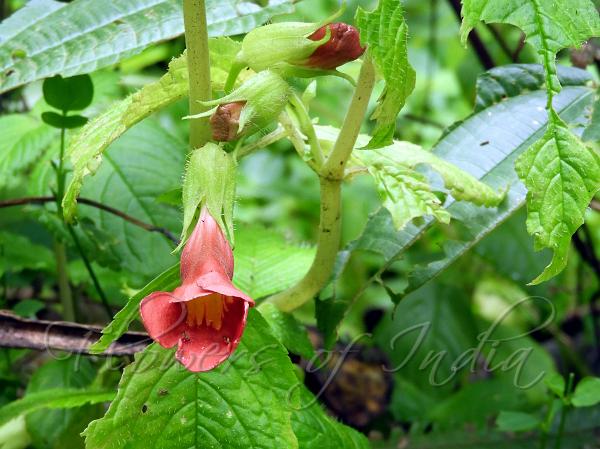|
| Red Henckelia |
|

|

| File size | 859116 |
| Original date | 7/19/19 10:39 AM |
| Resolution | 3888 x 5184 |
| Flash | Flash did not fire, auto |
| Focal length | 20.6mm |
| Exposure time | 1/60s |
| Aperture | 5.0 |
| Focus Distance | |
| Metering Mode | Multi-segment |
| Camera make | NIKON |
| Camera model | COOLPIX B700 |
| Sensor type |
|
|
|
|
Photo: |
Botanical name: Henckelia lallanii Family: Gesneriaceae (Gloxinia family)
Red Henckelia is a perennial erect herb,
50-100 cm tall. It is different from all other species of Henckelia by
its reddish orange corolla and only 1-flowered cyme. The species is
named after Mr. Lallan Singh, a great nature lover and father of one of
the discoverers of the species. Flowers are borne singly in leaf-axils,
on flower-cluster-stalks 1-2.5 cm long, stout, flower-stalks 1.5-3.5
cm long. Sepal-cup is bell-shaped, fused up to 3/4 of its length,
1.8-2.6 cm long, light green,
5-lobed; tube 1.3-1.7 cm long; sepals unequal, 0.5-0.9 cm long,
narrowly triangular-ovate, tip tapering, reflexed, margins entire.
Flowers are funnel-shaped, 5-6.5 cm long, hairless on both sides,
2-lipped; tube 4.3-5.4 cm long, abruptly tapering towards base,
slightly curved, reddish orange outside above the middle and pale white
or creamy towards base, upper lip 2-lobed, reddish
orange on both sides; lobes equal, round, 0.6-1 x 1-1.4 cm, tip
rounded, margins entire; lower lip 3-lobed, reddish orange on both
sides; lobes broadly obovate, 0.7-1.1 x 0.9-1.3 cm, tip blunt-rounded,
margins entire. Stamens are 2, creamy, inserted 1.7-2 cm above from the
flower base, hairless; filaments 1-1.2 cm long, staminodes 2. Pistil is
3.5-4 cm long. Stem is
round, unbranched, green, hairless, rooting from the base; internodes
7-18 cm long. Leaves are in opposite perpendicular pairs,
elliptic-ovate, 3-7.5 x 2-4 cm, tip pointed, base blunt-rounded or
broadly wedge-shaped or slightly oblique, margins rounded toothed to
toothed, above sparsely or densely hairy or becoming hairless; lateral
veins 7-11 pairs. Leaf-stalks are 1-4 cm long. Capsules linear, 12-16.5
cm long, pale green, without persistent disc and sepal-cup, hairless.
Red Henckelia is known only from Arunachal Pradesh. Flowering:
July-August.
| Identification credit: Momang Taram | Photographed in Potin, Lower Subansiri district, Arunachal Pradesh. |
• Is this flower misidentified? If yes,